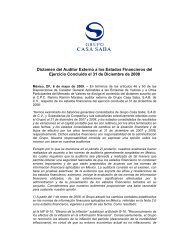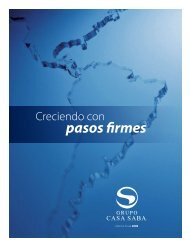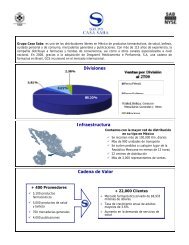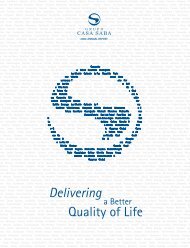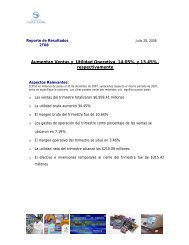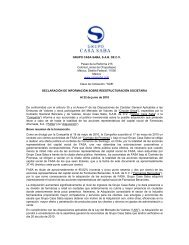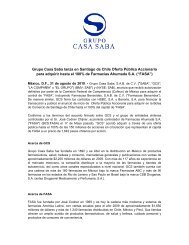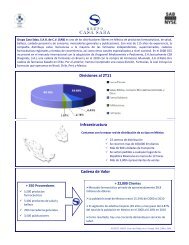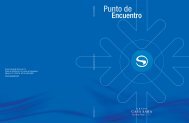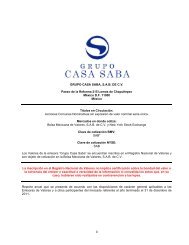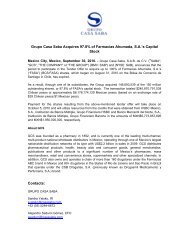FORM 20-F Grupo Casa Saba, S.A.B. de C.V.
FORM 20-F Grupo Casa Saba, S.A.B. de C.V.
FORM 20-F Grupo Casa Saba, S.A.B. de C.V.
Create successful ePaper yourself
Turn your PDF publications into a flip-book with our unique Google optimized e-Paper software.
Table of Contents<br />
24. Supplementary U.S. GAAP disclosures:<br />
a) Financial instruments with off-balance-sheet risk<br />
Un<strong>de</strong>r ASC 825, “Disclosure of information about financial instruments with off-balance sheet risk and financial instruments with concentrations of credit risk”, the Group sells its<br />
products mainly to distributors including supermarket chains, pharmacies and retail customers throughout Mexico, as well as Rio <strong>de</strong> Janeiro, Brazil, and effective October <strong>20</strong>10, Chile and<br />
Peru. No single customer accounted for a significant amount of the Group’s sales in fiscal <strong>20</strong>11, <strong>20</strong>10 and <strong>20</strong>09, and there were no significant accounts receivable from a single customer<br />
for the same years. Moreover, there is no significant concentration of a specific supplier relating to the purchase of inventories.<br />
The Group currently does not have any off-balance sheet arrangements that has or is reasonably likely to have a current or future material effect on the financial statements, changes in<br />
liquidity, capital expenditures or capital resources that are material to investors.<br />
b) Accounts receivable<br />
The majority of the Group’s accounts receivable is due from companies in the pharmaceutical products activities. Credit is exten<strong>de</strong>d based on evaluation of a customer’s financial<br />
condition, and generally, collateral is not required. Accounts receivable are due within a 60-1<strong>20</strong> day term and are stated at amounts due from customers net of an allowance for doubtful<br />
accounts. Accounts outstanding longer than the agreed upon payment terms are consi<strong>de</strong>red past due. The Group <strong>de</strong>termines its allowance by consi<strong>de</strong>ring a number of factors,<br />
including the length of time tra<strong>de</strong> accounts receivable are past due, the Group’s previous loss history, the customer’s current ability to pay its obligation to the Group, and the condition<br />
of the general economy and the industry as a whole. The Group writes off accounts receivable when they become uncollectible, and payments subsequently received on such<br />
receivables are credited to income.<br />
c) Impairment of other long-lived assets<br />
Un<strong>de</strong>r U.S. GAAP, an impairment occurs when the amount of the estimated future cash flows that may be reasonably expected to be obtained through the use of the property and<br />
equipment during its remaining economic useful life, reduced by the operating costs and expenses associated with such cash flows, is less than the net carrying value of this<br />
assets. The impairment that must be charged to operations is the amount by which the net book value exceeds its recovery value. Other long-lived assets, including amortizable<br />
intangibles, are tested for impairment if impairment triggers occur. Bulletin C-15, “Impairment of the value of long-lived assets and their related disposal” of Mexican FRS is virtually<br />
i<strong>de</strong>ntical to U.S. GAAP, except that the reversal of the recognition of impairment is permitted un<strong>de</strong>r Mexican FRS, as well as that the impairment is charged in “other expenses, net”, in<br />
lieu of being charged to operations un<strong>de</strong>r U.S. GAAP.<br />
d) Business combinations<br />
ASC 805, “Business Combinations” sets forth gui<strong>de</strong>lines to accounting for the acquisition of business by using the purchase method. This guidance requires acquisition-date fair<br />
value measurement of i<strong>de</strong>ntifiable assets acquired, liabilities assumed, and noncontrolling interests in the acquiree.<br />
The measurement requirements results in the recognition of the full amount of acquisition-date goodwill, which inclu<strong>de</strong>s amounts attributable to noncontrolling interests. The Group<br />
recognizes in income any gain on the remeasurement to acquisition-date fair value of consi<strong>de</strong>ration transferred or of previously acquired equity interests in the acquiree. Neither the<br />
direct costs incurred to effect a business combination nor the costs the acquirer expects to incur un<strong>de</strong>r a plan to restructure an acquired business are inclu<strong>de</strong>d as part of the business<br />
combination accounting. As a result, those costs are charged to expense when incurred, except for <strong>de</strong>bt or equity issuance costs, which are accounted for in accordance with other<br />
generally accepted accounting principles.<br />
F-63



